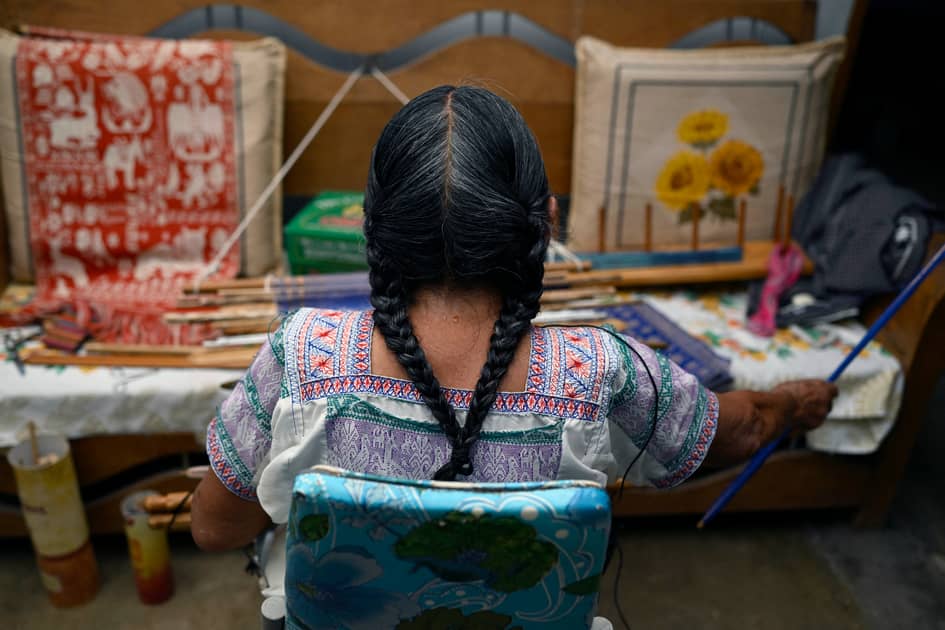Credits: Alfredo Estrella/AFP
After years of fighting for
greater recognition, Mexico's Indigenous weavers have seen their creations
thrust into the spotlight by the two women leading the country's presidential
race.
The brightly colored, elaborately embroidered garments handcrafted by
generations of artisans have long enchanted visitors to Mexico -- including
international designers whose use of the motifs have sparked accusations of
plagiarism.
Now an aficionado of the Indigenous designs is almost certain to become
Mexico's first woman president, although the prominence of the traditional
garments on the campaign trail has generated mixed feelings among their
creators.
"It's important that they don't just wear them as a costume or to attract
attention," said Trinidad Gonzalez, 55, a weaver in the community of El Mejay
in Hidalgo state in central Mexico.
Opposition candidate Xochitl Galvez, an outspoken businesswoman and senator
of Indigenous origin, has worn the traditional garments since entering
politics more than two decades ago.
Claudia Sheinbaum, the former Mexico City mayor who is representing the
ruling party and is leading the election race, has also worn Indigenous
designs during her campaign, including at its launch.
"It's very positive that Mexican textiles are center stage in the political
arena," said anthropologist Marta Turok.
But according to Andres Vidal, a doctor in social anthropology at the
National Autonomous University of Mexico, the choice of clothing is also part
of the "electoral game."
From racism to prestige
Martina Cruz -- Gonzalez's mother -- is 83 years old, but she still weaves
using techniques passed down through generations.
She is happy to see traditional clothing worn by the presidential
candidates, especially Galvez, who also hails from Hidalgo.
"I like it a lot," Cruz said, while weaving a garment that can take up to
eight months to make and is sold for the equivalent of $1,000.
The painter Frida Kahlo was the first internationally prominent Mexican
personality to wear Indigenous clothing, said Turok, an expert in popular art.
In politics, the pioneer was Maria Esther Zuno, wife of Luis Echeverria,
who was president from 1970 to 1976.
"Mexican politics is a reflection of society," Turok said.
At one time, politicians "were ashamed" to wear Indigenous clothing, a
reluctance that mirrored the wider problem of "discrimination and racism," she
recalled.
But gradually Indigenous designs gained popularity and prestige. Now they
can be worth thousands of dollars.
Cultural appropriation?
As a senator, Galvez promoted the adoption of the Day of the Huipil, held
on March 7 in recognition of the traditional embroidered blouse.
"Never haggle over the price of a huipil with an Indigenous woman," the
politician said in one of her videos, in which she showed her traditional
blouses, some made of silk that according to Turok would cost up to $5,000.
Sheinbaum, the granddaughter of Bulgarian and Lithuanian Jewish migrants,
also has a collection of Indigenous clothing given to her on tour, according
to a source from her campaign.
While several major foreign clothing brands have been accused by Mexico of
cultural appropriation for their Indigenous-inspired designs, Turok said she
did not view the candidates' use of the huipil in the same way.
"Improper cultural appropriation is taking a textile to another country to
reproduce it," she said.
"If we're going to start saying who can and can't wear them, it's going to
be a never-ending story," Turok added.
Vidal sees the use of Indigenous clothing as a way for politicians to
connect with voters.
"One way to reach them is by creating symbiosis through the use of a
certain type of clothing," he said.
The election fashion parade has brought new customers into Alfonso Giron's
store in Mexico City.
"They say, 'Hey, I'm looking for the garment I saw the candidate wearing on
television,'" he said.
But in reality, every huipil is unique, Giron added.(AFP)
http://dlvr.it/T5vQYx

No comments:
Post a Comment